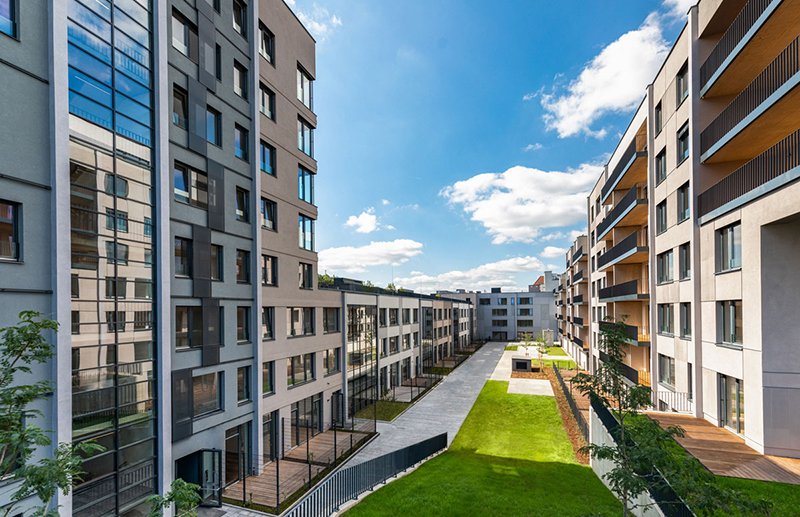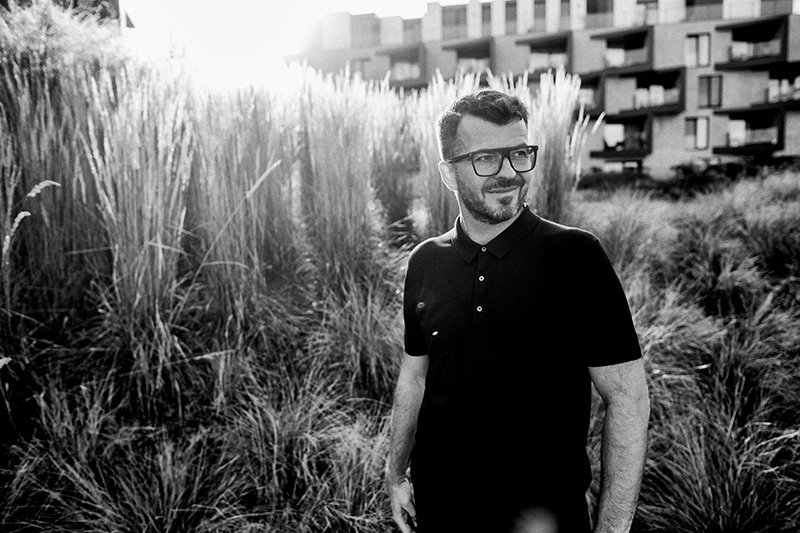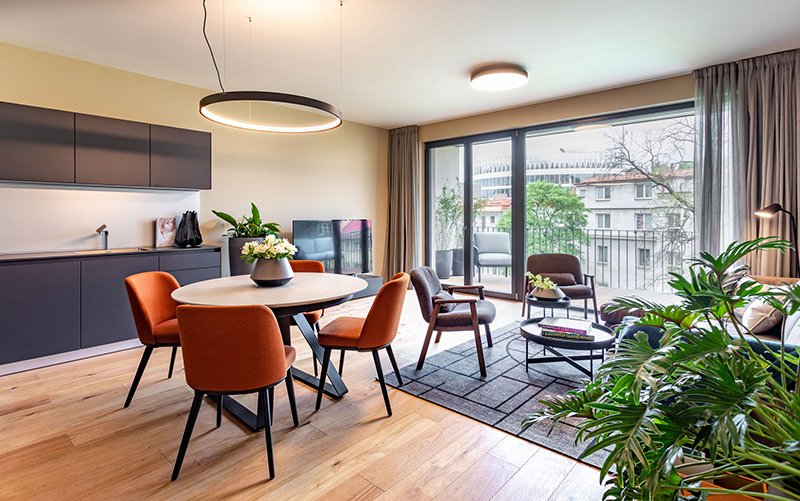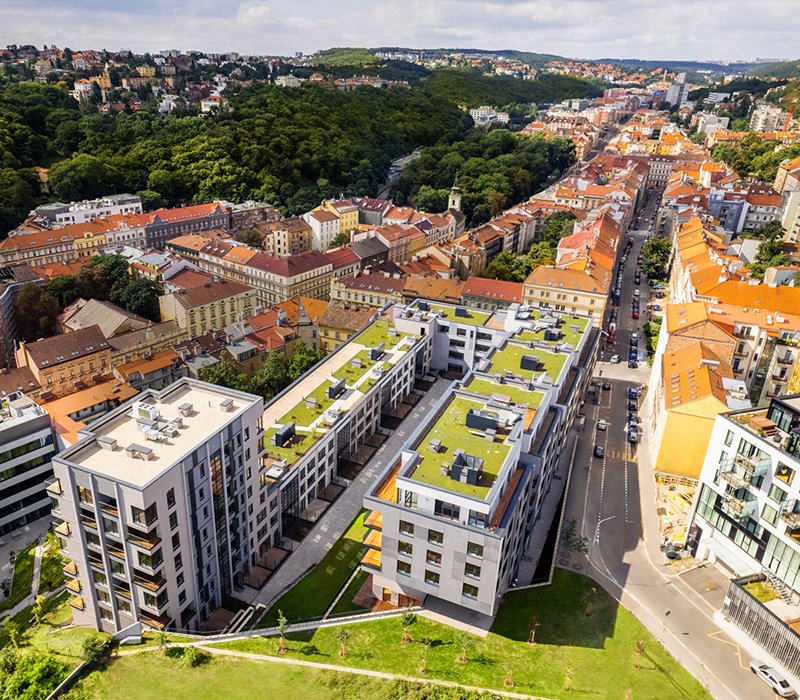6. 12. 2021
The only certainty is uncertainty
Such is the claim of architect David Chmelař, member of the Chmelař architects
studio and designer of numerous important buildings in Prague, northeastern
Bohemia and his native town of Hronov. He had gravitated towards architecture
since childhood and came up with fresh ideas in high school. How does he
perceive the importance of community space, the future of rental apartments and
the development of the DOCK complex? We asked him about all this in this
exclusive interview.

We are sitting together in offices that are part of the DOCK site. You yourself have left a very significant mark on these places, how do you view what has developed here over time?
I’m so pleased with what’s happened to DOCK. When we came here twelve years ago, there were only piles of rubble and demolished halls. That’s when we started building DOCK East, marking the beginning of the project. Since I live in Karlín, I often jog across the sluice Štvanice here and I am always delighted to see how lively it is here, how the complex is lush with greenery and how naturally it has fit into the surrounding landscape. I enjoy any view of the DOCK, for example, when they are thick with fog or at sunset. This part of the city is unrecognizable, its visage has emerged fantastically. Hats off to Omar and his team for what they’ve managed to build over the years.
How do you perceive slightly different architecture according to stages and the influence of the hands of time?
TThe fact that various architects have left their signature here is great because the diversity of the place adds a certain hallmark – it keeps the scale. Take, for example, housing estates such as Chodov or Řepy. In my opinion, it is a mistake to think that clinging to a kind of “corporate identity” is right. It can never work. With this type of project, you already feel a priori that the developer wanted to save on something - on the architects, on the material… And that’s not fair, because people pay basically the same money for such housing. I don’t think investing in something that cheats me is good. At DOCK, I like that you find various secluded places, I enjoy the great variety.
You say that generosity is important for developers, I quote exactly: “It is important that even people in top management know that construction must have added value.” What added value do you perceive in our country?
There was no effort to get the most out of the area here, and all buildings have a scale pleasant to live in. The barrier made of office buildings has succeeded, whose task is not just to offer as many square meters as possible, where people sit closed up in air-conditioned rooms, and when they come out into the fresh air in the afternoon, they are intoxicated. The office buildings in DOCK have generous terraces that descend beautifully towards the river, lending great views, and the buildings can also be ventilated.
Added value is found in the creation of characteristic spaces that are authentic and cannot be experienced elsewhere. It is the genius loci of a place where something unrepeatable grew out of a green meadow. Here, different architectural studios worked on each stage, and thus a certain “patchwork” was achieved that ultimately works very well.
One of the other projects on which you collaborated with CRESTYL was the Neugraf residential project, which, by the way, is currently up for sale. What added value would you highlight in this case?
Neugraf was also about bringing to life the neglected Brownfield left behind from the printing plants and the devastated land after construction of the Strahov tunnel. It was basically a squat. The site was home to a building that was cultivated by Satpo, which had built three Sacre Coeur projects. And Neugraf continued in this, which nicely returns the urbanism of Smíchov by closing off the block and providing continuity to the original apartment buildings. It will no longer be just a plant where people come and go. A place was born where people will live, and that transformation is unbelievable.
There is one specificity at Neugraf, and that is the idea of community spaces, which is not yet common in Czech projects...
This is thanks to an enlightened investor willing to finance the common parts of the building, even without receiving extra money for it. In Neugraf, people have their own private space on the roof, in the courtyard, and in the basement, they have a wellness facility - these are all places where they can meet their friends from the outside and from the building. Interaction and social contact develop. I think the scale of this project is at the upper limit of where people are still able to get to know each other and form a community. If we mention the urban planner Jan Gehl, he has calculated how many people are still able to form a community and get to know each other through meeting. This needs to be considered when executing urban planning and creating various interspaces and common areas. I think it’s a pioneering thing in Prague; we try to offer it to our clients in new projects, but of course enlightenment is key. To make people feel that they are not just some material that is to be sold and make a profit, but that they themselves are creating their city, the life in it.

How much do the trends, or rather the demands, for housing change at a time when the home office is a big phenomenon due to Covid-19? And how does the vision of an architect and a developer affect the lifestyle of millennials?
I think it is too early to draw a general conclusion of what the pandemic has meant for us in the development of the construction industry. Construction is like a steam locomotive - it moves by inertia... And since we’ve been building buildings to stand decades, some for hundreds of years, we expect them to last, so material selection reflects that. And all this requires a certain amount of energy, time and procedures. Into this came a global impetus that has greatly affected the price of real estate. People have started to buy cabins and cottages, and this will probably have an impact on the layout of apartments. We will think more about where to create a corner for telephoning, or a workspace, because as it turns out, many occupations can be pursued remotely, and that is a positive thing. We have to focus on that and emphasize those places. It is no novelty for someone to have their own office at home, but now rather the demand for terraces and balconies has increased, which links back to this. People think more about their environment.
But this is definitely a good trend ...
Yes. And that’s why I don’t quite understand when someone lives in a rented house and looks out at a weedy yard. Personally, I like gardening, so I would assume that if there are people e.g. of retirement age, they will weed out the space, mow the lawn and perhaps build a bench for themselves there since it is part of their dwelling. I hope that the pandemic will not only affect consumption, but also that people will invest more energy in their surroundings. There are local groups, such as in Karlín and Letná, who know this and cultivate their environment. For example, fixing up the grates around the trees, although it is often rather folk creativity, and it would take a “communal culture,” where the whole street would be arranged in a unified style. In the Upper East Side, New York City’s largest and most luxurious neighborhood, they have tulips in each tree grate unsoiled by animals, fenced in, and the street is thus beautified. So I’m looking forward to people learning that home is not just a room to barricade oneself in. We have a phobia that someone will see us. The house has to be ideally outside of Prague, covered in coniferous shrubbery and behind a concrete fence so nobody can peek in. I consider it stupidity and selfishness; the individual is nothing, it is all about the group.
When you build residential buildings, do you consider the lifestyle of the 20+ generation that feels that they don’t even have to live here and can move away? Nomadism is probably more natural for them than for us.
Unfortunately, I think this is helped by today’s time when real estate is catching up with western prices. Real estate in the centers is owned by just a handful of families or companies and the rest are renters, which is a current trend and that’s probably good. I don’t think it’s normal for everyone to have their own apartment, since it can’t be ensured. In Switzerland, only a small percentage of properties are owned by private individuals and the rest have to rent them. But based on that, people can be flexible, they don’t get tied down so much and aren’t encumbered by a mortgage. If they divorce, the problem is that there are not two salaries, but one, and what about the apartment then? The situation is then full of unnecessary stress, whereas if they are renting the apartment, they simply go and rent two smaller ones. In this spirit, it is also necessary to think in our field, and therefore in development. More projects will have rental apartments. Greater comfort and service means higher rents, and such apartments will be located in a certain part of the city. Though interweaving is best, living in the center will always be for only a handful of people who can afford it. But, for example, there is a lot of land in the area that can be built up, and it can be done smartly so that people intermingle, work there and live there. This would be the best for the city. So it is ideal to invest more in urban planning.

Should the developer, and therefore the architect, adapt to market trends, or is it better to work with a consistent vision?
It can’t be done only based on surveys, as Babiš did in politics. For example, the European Green Deal is right in principle, but it must not be overdone. We must think of the whole, of all. To be a bit of a communist, not in the true sense of the word, but rather in the fact that everyone has security by default. Freedom is not about being able to do what I want, but about respecting those around me.
How do you personally follow the demands of the times? Do you let them get to you?
It is fundamental to react to one’s environment. Someone asked me at a lecture if I didn’t have to study anymore, if I had already reached the maximum. No I haven’t and I never will. You have to be constantly on the lookout, new impulses and technologies keep coming, everything is evolving and changing, and you can’t become complacent. It is crucial to monitor the developmental stages, whether in construction or some thought processes and property matters. No one can stop the fact that people won’t be able to afford a mortgage due to high cost. The situation is approaching where a handful of the rich will rent housing, and we can only react to this. You have to take it for granted, those are the conditions. It’s not negative or positive, that’s just the way it is.
What do you imagine under the term “warmth of home”? What brings warmth of home to your home?
Warmth of home? The smell of food, heating itself and the fact that I’m there with people I love. That is home.
It is known that you are involved in improving public space in Hronov, where you grew up. Do you feel like a patriot? What draws you back home?
I definitely feel like a patriot. I’m from a small town and I like it there, the landscape is invigorating. We have families there, my wife is from Hronov too, so we like to go back there. We are in the environment in which we grew up, which is natural for us, so we take it as home. So it’s a homecoming, but of course I realize that the place has its limits, and that that environment is sometimes not as inspiring as the city. But I like having the choice when I’m overwhelmed sometimes that I can just come back to Hronov. Alternating like this is refreshing.
What place or building would you point out to us if we wanted to go to the Hronov area? What is worth seeing?
As part of Architecture Day, I made a guide to Hronov, so I can send you a list (laughs). Northeast Bohemia is beautiful for its First Republic architecture, which was introduced there by local entrepreneurs and factory workers. If I mention the most important buildings, one is the chateau restored by Jurkovič in Nové Město nad Metují town. The Bartoň family invited Otakar Novotný and another of the brothers had such a city palace built, generous and beautiful. It is today’s library in Náchod. I suspect that their father built a villa with Pavel Janák, and these names appear there, because when it worked, they had apartment buildings built in the center of Náchod. Hronov also has a villa by Heinrich Kulka, who worked alongside Adolf Loos. That is, there is a villa in Hronov having the same round plan as the Villa Müller in Prague in Ořechovka, which one wouldn’t expect at all. Jindřich Freiwald was born in Hronov. It is a paradox that he designed a building directly opposite my residence in Karlín. I like that I can look at a building built by a Hronov native. He also built for the savings bank Česká spořitelna, so there are a lot of cities with a theater or a savings bank by Freiwald. This is definitely the best thing I can mention about Hronov. Furthermore, there are contemporary architects. Despite being a small town, we have the interior of the year by Josef Mádr, who worked with Ivan Kroupa. It is a bowling alley with round windows in the shape of spheres, which is completely lined with cut concrete. We’ve tried to contribute, having made an ice rink, a square, a park.
When did you first start thinking about architecture in a different way?
I don’t even know (laughs).
Did you gravitate to it as a child?
Yes, I was so taken by it as a child already, I even competed with Studio Kamarád. That was the first time. At that time, I was very interested in a TV series where they had a striped bench and it stretched through the space like a snake. I still have that in my head. Then I was with my relatives at a castle, where there was like an endless tangled lattice by Jože Plečnik. And then there were those chocolates, the tiles from the 1st Republic in Náchod in the pedestrian zone. It really looks like white chocolate bars. So those were my first impressions. I have no idea how old I might have been, but I thought I might enjoy it, and then I started designing my own houses, so I have a stack of different sketches. I was also very engrossed when something came from abroad, because everything was gray here under totalitarianism. Like the Ikei or Quelle catalog…I was shocked. I would then redraw things differently. I used everything that was colored because there was nothing colored here. Additionally, there were the popular magazines about home living - Schöner Wohnen. Or car catalogs from America; those cars were always photographed in front of some house. So I designed houses for myself, I had a few plots of land in Hronov (laughs). We then learned to dimension in high school, and I got the idea that I would like to create a circular layout. And those teachers were shocked because I made a round bathroom, and they couldn’t quite tell me how to dimension it. I did other projects by consulting on them in the Tsunami studio. I then moved on to college, and in my freshman year, I started building the first house for a client, so that marked the start of my company.
Do you think the profession of architect is built more on a gift from God, or is it about craftsmanship, diligence and effort?
Who is successful will tell you that diligence and effort are most important. But then it is talent that makes one stand out from the crowd. Plenty of people can do it, but to rise above, there has to be something extra. Our field is given by the fact that it is not entirely art, but it is also not only a technical field that can be learned according to some tables such as statics or technical equipment of buildings. It is half technical and half artistic, and you have to be careful that there is nothing more, because it becomes noticeable. When someone is more of an artist, their houses do not hold together and age poorly because the details are not strong enough to withstand. So quality buildings arise from a perfect balance between art and technology. I compare our work to directing. A director must be aware of the professions of those around him, but he can’t really know them himself so he just organizes them and tries to incorporate them into a whole in order to achieve his vision. It takes a lot of imagination and that has to be innate, as well as the ability to find a way to pass on that vision to the people around him. You don’t even have to be able to draw, but it’s a big advantage to be able to communicate an idea like that. It’s the fastest and a relatively important way to present what’s in your head. Next, you need to have the gift to persuade someone to pay, because it affords them something extra.
Is there a building in our country that fascinates you and that you won’t get tired of?
There is a whole constellation of them. The Orangery by Eva Jiřičná, then, of course, modifications by Plečnik at Prague Castle, Villa Müller. Those ones occur to me off the top of my head. When I was in college, I drew an orangery and it made me sweat a lot (laughs).
Do you have a role model, or role models, someone who can completely disarm you with their work?
Sure. Of course the duo Herzog and de Meuron, Rem Koolhaas, MVRDV studio, Japanese Kazuyo Sejima and Ryue Nishizawa. But the Dutch lead; they are far ahead of everyone in urbanism. This results from the fact that they are always fighting against high sea levels. They have to really think about how to design something so that water does not flood the territory and that they can work with it. They have it very well engineered for many reasons. And then, for example, Eva Jiřičná, I have a weakness for her. The first thing I discovered in high school was her glass staircase, which blew me away. How she works with glass, steel, her cobweb pattern ...

What would you be if you were not an architect? What else would you enjoy doing?
Maybe designing clothes. Fashion. But definitely designing something, drawing. Or painting. I have even planned a studio behind the house for when I retire. I would enjoy that. Something artistic, even sculptures.
What advice would you give to students for whom you can be a role model?
A role mode (laughs)? That’s a difficult one. Probably humility. To first check out what others are working on and not think I’m smarter ... Great confidence is a good stimulus that helps us distinguish ourselves and move forward. But it’s good to know from the beginning that I can’t do anything at all, and work on this to be able to learn something and know something. Because when young people come and think they’re hot stuff because they won a competition, they really aren’t. It is a craft that needs to be learned. You can always tell when the craft isn’t there. Medieval workshops were not bad at all, where people learned to make a hand first, then drapery... It is the same for buildings, it is necessary to start with the interior, to design, for example, a cabinet, an apartment, then a house, then a larger house. And to develop a feel for what materials belongs together, so that it is not just a gesture. I can make a house out of cardboard, and it will get wet after the first winter. It’s a good effect, the magazine prints it because it’s something new, but for me it’s just a gesture. It’s just necessary to humbly learn that a brick costs a certain amount of money, and not everyone can afford it. If someone wants a house made of exposed concrete, they say: “Is it really supposed to be a family house made of exposed concrete? Just because I saw it in a picture in a magazine? Do I want it at all costs?” Actually, it isn’t important to those people at all. But you will begin to perceive it by the procedure. Excessive self-confidence is a trait possessed by youth, but sometimes it can be limiting.
Thank you for the interview.